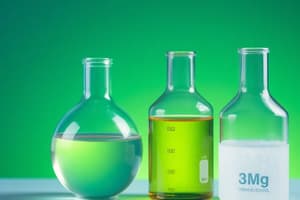Podcast
Questions and Answers
Define the solution and list its properties.
Define the solution and list its properties.
A homogeneous mixture of two or more substances is called a solution. Its properties include: 1) It shows the properties of its components; 2) Its components are variable.
What are the components of a solution?
What are the components of a solution?
The components of a solution are solute and solvent.
What is a saturated solution?
What is a saturated solution?
A saturated solution is a solution in which the amount of solute cannot be dissolved at a particular temperature.
How is a saturated solution prepared?
How is a saturated solution prepared?
Define an unsaturated solution.
Define an unsaturated solution.
Define a super saturated solution.
Define a super saturated solution.
Differentiate between dilute and concentrated solutions.
Differentiate between dilute and concentrated solutions.
Define an aqueous solution.
Define an aqueous solution.
How many physical states of solutions are there?
How many physical states of solutions are there?
How can you distinguish between a solution and a pure liquid?
How can you distinguish between a solution and a pure liquid?
What are common components of a soft drink?
What are common components of a soft drink?
Flashcards are hidden until you start studying
Study Notes
Solutions
- A homogeneous mixture of two or more substances is called a solution.
- Solutions exist in a single phase.
- Components cannot be distinguished from one another.
- Examples of solutions include sea water, air, soft drinks, and brass.
Properties of Solutions
- Solutions exhibit the properties of their components.
- The composition of a solution can be varied.
Components of a Solution
- Solute: The component present in a smaller quantity.
- Solvent: The component present in a larger quantity that dissolves the solute.
- Examples: In an aqueous salt solution, salt is the solute and water is the solvent. In soft drinks, water is the solvent, and carbon dioxide, salt, and sugar are solutes.
Saturated Solution
- A solution where no more solute can be dissolved at a given temperature is called a saturated solution.
- It contains the maximum amount of solute possible at that temperature.
- The dissolved and undissolved solute are in equilibrium.
- Preparation: Add solute to solvent until no more dissolves. Excess solute will settle at the bottom of the container.
Unsaturated Solution
- A solution where more solute can be dissolved at a given temperature.
- Contains less solute than required to saturate it.
Supersaturated Solution
- A solution that is more concentrated than a saturated solution at a particular temperature.
Dilute Solution
- Contains a relatively small amount of solute.
- Example: A solution containing 5g of sodium chloride (NaCl) in 1 dm3 of water.
Concentrated Solution
- Contains a relatively large amount of solute.
- Example: Brine, a concentrated solution of common salt (NaCl). 100g of NaCl in 1 dm3 of water would be a concentrated solution.
Aqueous Solution
- A solution in which water is the solvent.
- Examples: Sugar in water, salt in water.
Physical States of Solution
- Gaseous Solutions: Example: Air
- Solid Solutions: Example: Alloys, dental amalgam.
- Liquid Solutions: Example: Sea water, soft drinks.
Identifying Solutions and Pure Liquids
- Evaporation: A pure liquid will evaporate completely leaving no residue. A solution will leave a residue after evaporation.
Common Components of Soft Drinks
- Soft drinks are commonly composed of water (solvent), sugar, carbon dioxide, flavorings, and preservatives.
Studying That Suits You
Use AI to generate personalized quizzes and flashcards to suit your learning preferences.




